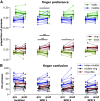Differential neural plasticity of individual fingers revealed by fMRI neurofeedback
- PMID: 33788634
- PMCID: PMC8887809
- DOI: 10.1152/jn.00509.2020
Differential neural plasticity of individual fingers revealed by fMRI neurofeedback
Abstract
Previous work has shown that functional magnetic resonance imaging (fMRI) activity patterns associated with individual fingers can be shifted by temporary impairment of the hand. Here, we investigated whether these neural activity patterns could be modulated endogenously and whether any behavioral changes result from this modulation. We used decoded neurofeedback in healthy individuals to encourage participants to shift the neural activity pattern in sensorimotor cortex of the middle finger toward the index finger, and the ring finger toward the little finger. We first mapped the neural activity patterns for all fingers of the right hand in an fMRI pattern localizer session. Then, in three subsequent neurofeedback sessions, participants were rewarded after middle/ring finger presses according to their activity pattern overlap during each trial. A force-sensitive keyboard was used to ensure that participants were not altering their physical finger coordination patterns. We found evidence that participants could learn to shift the activity pattern of the ring finger but not of the middle finger. Increased variability of these activity patterns during the localizer session was associated with the ability of participants to modulate them using neurofeedback. Participants also showed an increased preference for the ring finger but not for the middle finger in a postneurofeedback motor task. Our results show that neural activity and behaviors associated with the ring finger are more readily modulated than those associated with the middle finger. These results have broader implications for rehabilitation of individual finger movements, which may be limited or enhanced by individual finger plasticity after neurological injury.NEW & NOTEWORTHY It may be possible to remobilize fingers after neurological injury by altering neural activity patterns. Toward this end, we examined whether finger-related neural activity patterns could be modified in healthy individuals without physical intervention, using fMRI neurofeedback. Our findings show that greater variability of neural patterns at baseline predicted a participant's ability to successfully shift these patterns. Because neural variability is common in individuals poststroke, this illustrates a potential clinical benefit of this procedure.
Keywords: fMRI; finger; neurofeedback; plasticity.
Conflict of interest statement
No conflicts of interest, financial or otherwise, are declared by the authors.
Figures








Similar articles
-
A simulation-based approach to improve decoded neurofeedback performance.Neuroimage. 2019 Jul 15;195:300-310. doi: 10.1016/j.neuroimage.2019.03.062. Epub 2019 Apr 4. Neuroimage. 2019. PMID: 30954707 Free PMC article.
-
Long-term training-dependent representation of individual finger movements in the primary motor cortex.Neuroimage. 2019 Nov 15;202:116051. doi: 10.1016/j.neuroimage.2019.116051. Epub 2019 Jul 24. Neuroimage. 2019. PMID: 31351164
-
Structure of Population Activity in Primary Motor Cortex for Single Finger Flexion and Extension.J Neurosci. 2020 Nov 25;40(48):9210-9223. doi: 10.1523/JNEUROSCI.0999-20.2020. Epub 2020 Oct 21. J Neurosci. 2020. PMID: 33087474 Free PMC article.
-
Toward a comprehensive understanding of the neural mechanisms of decoded neurofeedback.Neuroimage. 2019 Mar;188:539-556. doi: 10.1016/j.neuroimage.2018.12.022. Epub 2018 Dec 17. Neuroimage. 2019. PMID: 30572110 Free PMC article. Review.
-
The potential of real-time fMRI neurofeedback for stroke rehabilitation: A systematic review.Cortex. 2018 Oct;107:148-165. doi: 10.1016/j.cortex.2017.09.006. Epub 2017 Sep 18. Cortex. 2018. PMID: 28992948 Free PMC article.
Cited by
-
Graded fMRI Neurofeedback Training of Motor Imagery in Middle Cerebral Artery Stroke Patients: A Preregistered Proof-of-Concept Study.Front Hum Neurosci. 2020 Jul 14;14:226. doi: 10.3389/fnhum.2020.00226. eCollection 2020. Front Hum Neurosci. 2020. PMID: 32760259 Free PMC article.
-
Sculpting new visual categories into the human brain.Proc Natl Acad Sci U S A. 2024 Dec 10;121(50):e2410445121. doi: 10.1073/pnas.2410445121. Epub 2024 Dec 3. Proc Natl Acad Sci U S A. 2024. PMID: 39625982 Free PMC article.
-
Towards a common template for neural reinforcement of finger individuation.Sci Rep. 2021 Jan 13;11(1):1065. doi: 10.1038/s41598-020-80166-8. Sci Rep. 2021. PMID: 33441742 Free PMC article.
-
Evaluating the Feasibility of Visual Imagery for an EEG-Based Brain-Computer Interface.IEEE Trans Neural Syst Rehabil Eng. 2024;32:2209-2219. doi: 10.1109/TNSRE.2024.3410870. Epub 2024 Jun 19. IEEE Trans Neural Syst Rehabil Eng. 2024. PMID: 38843055 Free PMC article.
-
Conducting decoded neurofeedback studies.Soc Cogn Affect Neurosci. 2021 Aug 6;16(8):838-848. doi: 10.1093/scan/nsaa063. Soc Cogn Affect Neurosci. 2021. PMID: 32367138 Free PMC article.
References
Publication types
MeSH terms
Grants and funding
LinkOut - more resources
Full Text Sources
Other Literature Sources

